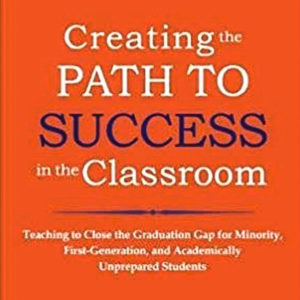By Jonathan Stubblefield | In this article, the author reviews Kathleen F. Gabriel’s 2018 book Creating the Path to Success in the Classroom: Teaching to Close the Graduation Gap for Minority, First-Generation, and Academically Unprepared Students. The book offers instructors both theories and practical tips for implementing inclusive success strategies within the classroom environment. The review identifies the primary purpose of the book, reviews key themes, explores a chapter in detail, and offers a critique of the entire work.
Creating the Path to Success in the Classroom: Teaching to Close the Graduation Gap for Minority, First-Generation, and Academically Unprepared Students. By Kathleen F. Gabriel. Sterling, VA: Stylus Publishing. 2018. ISBN: 9781579225568. 190 pages. Paperback, $27.50.
Author Note
Jonathan Stubblefield, Residence Life, Western State Colorado University. Correspondence regarding this book review should be addressed to Jonathan Stubblefield, Resident Director, Residence Life, Western State Colorado University, 600 N. Adams Street, Gunnison, CO 81231. Phone: (970) 943-2101. E-mail: jestubblefield@gmail.com
Book Review: Creating the Path to Success in the Classroom: Teaching to Close the Graduation Gap for Minority, First-Generation, and Academically Unprepared Students, by Kathleen F. Gabriel
 While efforts to retain minority, low-income, first-generation, and academically at-risk students are prevalent within student affairs divisions at colleges and universities, discussions about retention from the faculty perspective are not as frequent. In Creating the Path to Success in the Classroom: Teaching to Close the Graduation Gap for Minority, First-Generation, and Academically Unprepared Students, Kathleen F. Gabriel—an educational consultant who served previously as a high school social science teacher and an associate professor at California State University, Chico—makes a convincing case for why and how faculty are critical to creating communities of learners and promoting success for all students, especially those traditionally seen as at-risk. This book is a companion to Gabriel’s 2008 Teaching Unprepared Students: Strategies for Promoting Success and Retention in Higher Education, though the two are stand-alone volumes. Her recent book is aimed at instructors at all types of higher education institutions—community colleges and universities alike—and reviews key strategies that faculty should consider integrating into their classrooms using a mix of theoretical philosophies and practical tips for applying those theories.
While efforts to retain minority, low-income, first-generation, and academically at-risk students are prevalent within student affairs divisions at colleges and universities, discussions about retention from the faculty perspective are not as frequent. In Creating the Path to Success in the Classroom: Teaching to Close the Graduation Gap for Minority, First-Generation, and Academically Unprepared Students, Kathleen F. Gabriel—an educational consultant who served previously as a high school social science teacher and an associate professor at California State University, Chico—makes a convincing case for why and how faculty are critical to creating communities of learners and promoting success for all students, especially those traditionally seen as at-risk. This book is a companion to Gabriel’s 2008 Teaching Unprepared Students: Strategies for Promoting Success and Retention in Higher Education, though the two are stand-alone volumes. Her recent book is aimed at instructors at all types of higher education institutions—community colleges and universities alike—and reviews key strategies that faculty should consider integrating into their classrooms using a mix of theoretical philosophies and practical tips for applying those theories.
Gabriel starts by identifying challenges. While access to higher education has improved and while economic empowerment is a primary reason students seek out a college degree, many students, especially those identified as minority, low-income, first-generation, or academically at-risk, drop out prior to degree attainment. Gabriel argues that it is possible—necessary, in fact—for faculty to be key players in retention efforts of students by fostering communities of learners with appropriate instructor-student and peer-peer interactions while keeping expectations for academic performance and degree attainment high.
Each chapter of Creating the Path to Success in the Classroom offers a mix of research, usually tied to student development or learning theories, and big-picture views of why certain factors, such as a growth mindset, are relevant for students. The first two chapters discuss issues related to retention and classroom climate, though most of the book explores more specific aspects of teaching, such as lectures, writing assignments, and classroom discussions. Incorporating theory and practice in this way, while adopting a writing style grounded in personal stories and explanations, Gabriel makes a complete read-through of the book both enjoyable and educational. Yet, the structure also serves as a useful quick reference on classroom strategies around specific topics, such as when an instructor is struggling with students who are not completing their assigned readings.
For example, Chapter 5 examines interactive lectures. It begins by reviewing the traditional purpose of lectures—passing information to large numbers of students in a short time period—and challenges why most traditional lectures do not actively engage learners. Instead, such lectures encourage passive learning that could lead to a lack of focus. Rather than dismiss outright the traditional lecture format, however, Gabriel shares strategies for making lectures more engaging, like incorporating activities into lectures, encouraging students to work with and get to know other students from different backgrounds, and using specific techniques to facilitate and grade in-class activities (e.g., write-pair-shares, gallery walks, case studies, and having students vote to share their voice). In addition, the chapter highlights best practices for presenting lectures, including prevalent tips such as using visual aids appropriately as well as a refreshing look into the research of giving students a full or partial set of notes, an outline of information, or no notes on their learning effectiveness. As with all other chapters, Chapter 5 represents an appropriate mix of theoretical frameworks and comparisons, and it details techniques that accompany those frameworks.
Not only does this combination of theory and practice add value to the field of student learning, its emphasis on diversity and inclusion is woven throughout many narratives and descriptions of techniques, as well as the appendices. Gabriel examines this most thoroughly in Chapter 4, which focuses on motivation and attitudes. She argues that it is detrimental for students to be labeled into groups, since such categorization contributes to self-defeating behaviors. Faculty who fault high schools for not appropriately preparing students for college do not help those students where they are now—in college. Indeed, the mindset of instructors is important, and the mindset of students themselves is also critical, especially since many have received messages that they are not good enough. Gabriel provides tips on countering this mindset by suggesting relevant articles, encouraging instructors to examine their own cultural identity and learn about other identity groups, and sharing stories of others who have faced adversities but have persisted and overcome them. Similar advice and theories are included in other chapters as well, such as a discussion about supporting students who cannot afford textbooks while still holding them to the class reading and writing expectations.
Although the book does offer many relevant and creative approaches to creating a community of learners, it focuses solely on the classroom setting. Although Gabriel makes a case for why it is necessary for instructors to view retention as a key component of their job, she does not fully discuss the impact of other retention efforts on college campuses. In fact, she briefly mentions in the first chapter a study by Tinto that found that retention gains have stagnated in recent years despite a plethora of retention initiatives, especially from staff. Reflecting on this awareness that most retention efforts yield lackluster results makes it hard for any reader to want to implement significant changes to their student services practice. Ideally, this sentiment could have been expanded upon to explore why this is the case, to share how particular retention efforts actually compliment the classroom environment, and to persuade the reader of the importance of retention techniques applied in classroom environments.
Overall, however, Gabriel’s book is a wonderful addition to the field of higher education. It offers a mix of theoretical discussions and practical tips to help instructors of all types improve the persistence of students, namely those who are minority, first-generation, and academically unprepared. It also encourages faculty to use culturally relevant stories and growth mindset language to better connect with students who are identified as minority or at-risk. In sum, this book effectively explores how to create an inclusive community of involved learners.
 Jonathan Stubblefield works at Western Colorado University as a Resident Director for a first-year complex. He was previously at University of Washington Tacoma as an academic advisor and at Missouri State University as a Graduate Teaching Assistant in First-Year Programs. He has taught career exploration, first-year foundation, and general psychology courses on those three campuses. Contact him at jstubblefield@western.edu.
Jonathan Stubblefield works at Western Colorado University as a Resident Director for a first-year complex. He was previously at University of Washington Tacoma as an academic advisor and at Missouri State University as a Graduate Teaching Assistant in First-Year Programs. He has taught career exploration, first-year foundation, and general psychology courses on those three campuses. Contact him at jstubblefield@western.edu.




